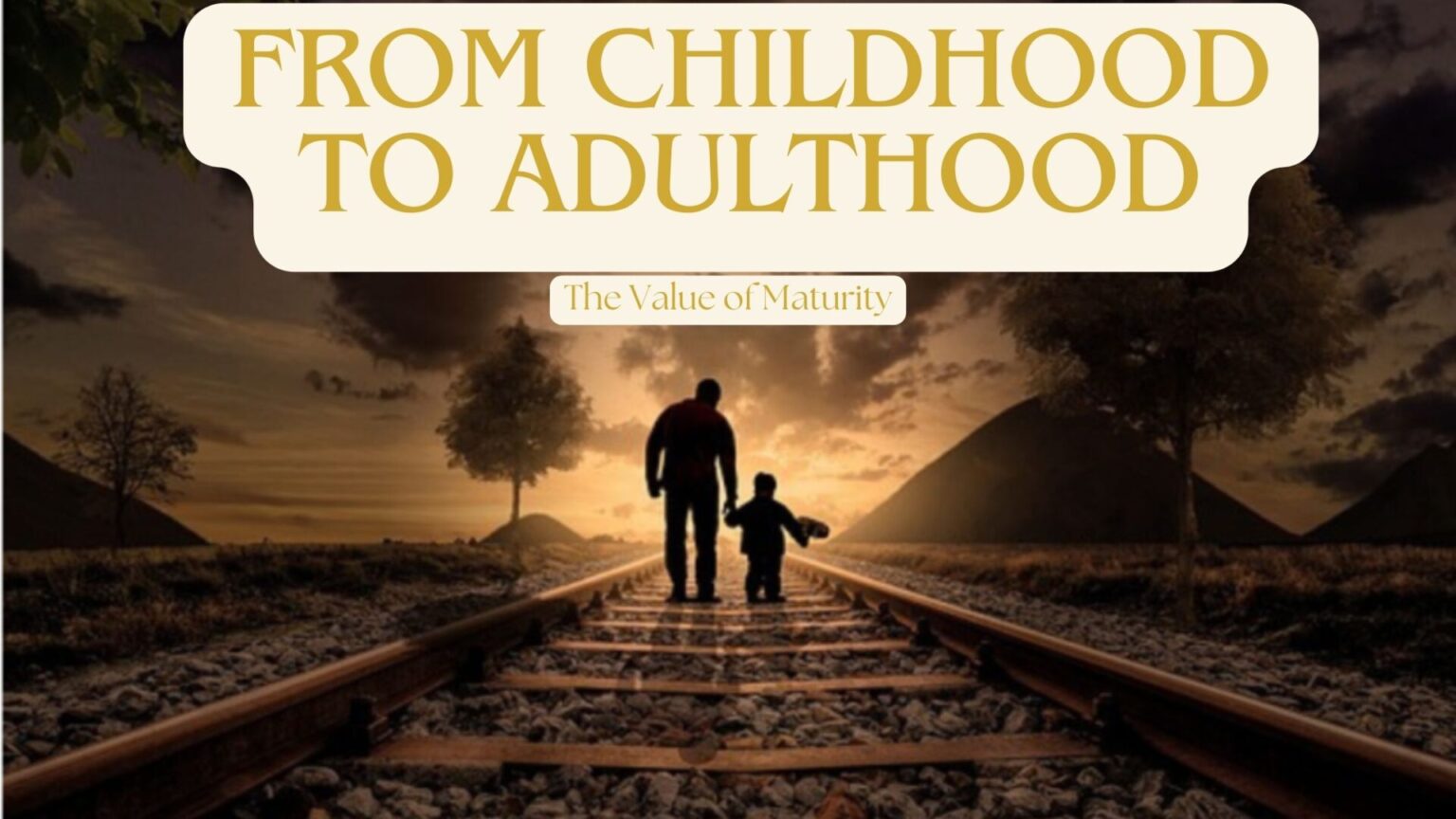Introduction:
Embracing Maturity: A Journey from Childhood to Adulthood

In the symphony of life, maturity plays a resounding note, weaving through the rhythm of our existence, guiding us from the innocence of childhood to the wisdom of adulthood. It is the beacon that illuminates our path, shaping our decisions, and molding our character. From the tender age of curiosity to the seasoned years of experience, the value of maturity is unparalleled, for it is the cornerstone upon which our growth and fulfillment rest.
What are the key milestones in transitioning from childhood to adulthood?
When transitioning from childhood to adulthood, various milestones differ based on culture and the individual. However, some common milestones include:
1. Physical Changes: Puberty is when physical maturation begins, including growth spurts, hormonal changes, and developing secondary sexual characteristics.
2. Cognitive Development: Adolescence is when cognitive development occurs, including enhancing problem-solving skills, abstract thinking, and decision-making abilities.
3. Educational Milestones: Graduating high school or completing higher education marks a significant step towards adulthood and independence.
4. Social and Emotional Development: Developing meaningful relationships, establishing independence from parents or guardians, and forming one’s identity are crucial to transitioning to adulthood.
5. Legal Milestones: Attaining the legal age of majority, which varies by country but is typically between 18 and 21, grants individuals certain rights and responsibilities, such as voting, signing contracts, and making medical decisions.
6. Financial Independence: Gaining financial literacy, securing employment, managing finances, and becoming financially independent are important aspects of adult life.
7. Living Independently: Moving out of the parental home and establishing one’s own household or living situation is a common marker of adulthood in many cultures.
8. Establishing Career or Vocational Goals: Identifying career aspirations, pursuing further education or training, and entering the workforce are significant steps toward adulthood.
9. Taking on Responsibilities: Assuming responsibilities such as paying bills, managing household chores, and caring for dependents are indicators of adult maturity.
10. Personal Development: Engaging in self-discovery, exploring personal interests, and pursuing personal growth and development contribute to the transition to adulthood. These milestones are not necessarily linear or universally experienced in the same way, and individuals may reach them at different times and in different sequences.
“How does maturity impact personal relationships?”
Maturity is important in personal relationships. It affects how people communicate, handle disagreements, show empathy, and maintain healthy boundaries. Here’s how maturity impacts different aspects of personal relationships:
1. Communication: Mature individuals communicate openly, honestly, and effectively. They say what they think and feel, listen actively to others, and try to understand different perspectives. This helps to resolve conflicts and build trust.
2. Conflict Resolution: Mature individuals approach conflicts calmly and rationally. They seek solutions rather than blaming or becoming aggressive. They are willing to compromise, apologize when necessary, and work towards mutually beneficial solutions. This helps to manage emotions during conflicts and leads to more productive and harmonious relationships.
3. Empathy and Understanding: Mature individuals show empathy and understanding towards their partner’s emotions, experiences, and needs. They can understand and feel what their partner is going through, which fosters emotional connection and intimacy. This enables them to support their partners through hard times and celebrate their successes with genuine joy.
4. Respect and Boundaries: Mature individuals respect their partner’s boundaries, autonomy, and individuality. They recognize the importance of mutual respect and consent in healthy relationships, and avoid controlling or manipulative behavior. This helps to establish and maintain healthy boundaries, which is crucial for fostering trust and mutual respect.
5. Commitment and Reliability: Mature individuals honor their promises and prioritize the well-being of their partners. They understand the importance of trust and loyalty in building strong, long-lasting relationships. This enables them to overcome challenges and setbacks together, strengthening the bond between partners.
6. Self-Awareness and Personal Growth: Mature individuals have a high level of self-awareness and are committed to personal growth and development. They reflect on their own behavior, learn from their mistakes, and make positive changes for the benefit of their relationships. This enables them to evolve and adapt as their relationships evolve, leading to greater resilience and fulfillment.
“Tips for fostering maturity in children and young adults?”
To help children and young adults mature, it’s important to create environments that encourage responsibility, independence, critical thinking, and emotional intelligence. Here are some tips:

1. Encourage independence: Let children make decisions and solve problems on their own, starting with small ones and increasing gradually as they get older.
2. Set clear expectations: Make sure children know the rules and what will happen if they don’t follow them. Be consistent in enforcing them.
3. Promote self-reflection: Help children think about their actions, feelings, and experiences so they become more aware of themselves and what they do.
4. Teach life skills: Teach children practical skills like cooking, cleaning, managing money, and managing time, so they’re prepared to live on their own eventually.
5. Encourage goal setting: Help children set achievable goals and work towards them. This teaches the importance of perseverance and planning for the future.
6. Provide decision-making opportunities: Let children make choices appropriate for their age and talk about the results.
7. Model responsible behavior: Show children how to be responsible by doing it yourself. Manage your finances, maintain healthy relationships, and take care of yourself.
8. Encourage emotional intelligence: Teach children how to recognize and manage their emotions, understand others’ feelings, and communicate well.
9. Promote critical thinking: Encourage children to ask questions, be curious, and think for themselves. This helps them make good decisions and understand information better.
10. Provide supportive guidance: Help children learn from their mistakes and take responsibility for their actions while giving them support and encouragement.
By following these tips when parenting, teaching, or mentoring, you can help children and young adults develop the skills, attitudes, and behaviors they need to mature and succeed in adulthood.
FAQs
- What is maturity?
Maturity is a multifaceted concept encompassing emotional, intellectual, and behavioral attributes. It involves the ability to navigate life’s challenges with wisdom, resilience, and empathy.
- How does maturity develop?
Maturity develops through a combination of life experiences, self-reflection, and personal growth. It is influenced by factors such as upbringing, education, and social interactions.
- What are the signs of maturity?
Signs of maturity include emotional stability, accountability for one’s actions, the ability to empathize with others, and a willingness to learn from mistakes.
- Can maturity be learned or cultivated?
Yes, maturity can be learned and cultivated through self-awareness, introspection, and a commitment to personal development. Seeking feedback, practicing empathy, and embracing challenges can contribute to the development of maturity.
- Why is maturity important?
Maturity is important because it enables individuals to navigate life’s complexities with resilience and grace. It fosters healthy relationships, effective decision-making, and personal fulfillment.
References:
- Arnett, J. J. (2000). Emerging adulthood: A theory of development from the late teens through the twenties. American psychologist, 55(5), 469-480.
- Erikson, E. H. (1968). Identity: Youth and crisis. WW Norton & Company.
- Kegan, R. (1994). In over our heads: The mental demands of modern life. Harvard University Press.
- Lapsley, D. K., & Power, F. C. (2005). Identity development and human flourishing: A synthesis of identity and positive psychology. Identity, 5(1), 21-38.
- Masten, A. S., Burt, K. B., & Coatsworth, J. D. (2006). Competence and psychopathology in development. Developmental psychopathology, 3, 696-738.






